Exploring One Carat Diamonds: Value and Beauty
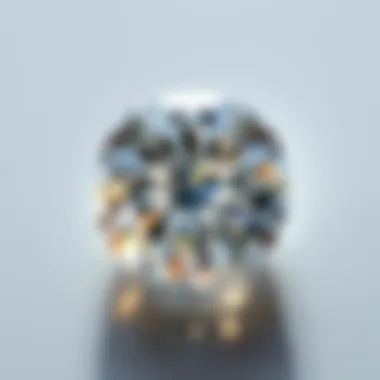
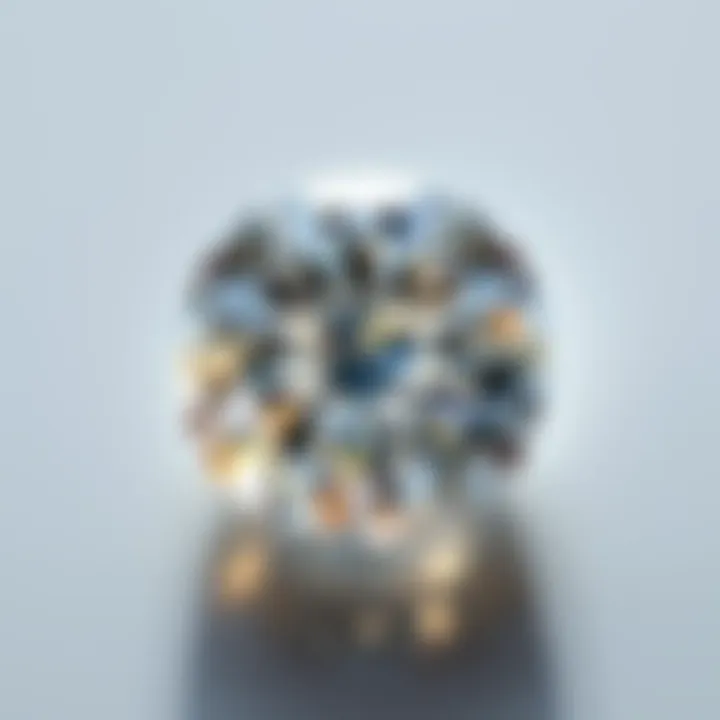
Intro
Diamonds have fascinated humans for centuries. There's a certain aura around one carat diamonds that elevates their charm above other gemstones. These perfect little wonders of nature come with a story of their own, encompassing a range of complexities in aspects like formulation, appearance, and valuation.
Engaging with one carat diamonds is not merely about their price tag; rather, it involves understanding the interplay of various elements such as clarity, cut, and color. This article will take readers deeper into the world of one carat diamonds, exploring not just their physical properties but also the journey each stone undertakes from formation to presentation. Gemstone enthusiasts, collectors, and even jewelry designers will find invaluable information that enhances their appreciation of these breathtaking gems.
Let’s embark on this exploration, unpacking the layers that contribute to the allure of a one carat diamond.
Overview of Gemstones and Minerals
Before we delve solely into diamonds, it's important to get a broader sense of where these exquisite stones fit within the kingdom of gemstones and minerals. Understanding the history and cultural significance of gemstones provides valuable context for their fascination.
History of Gemstone and Mineral Use
Gemstones are as old as time itself. From ancient civilizations to the modern world, people have adorned themselves with these stunning creations of nature. Ancient Egyptians practiced gem engraving, believing that stones like lapis lazuli hold protective properties. The Romans took gem usage a step further, creating intricate jewelry that served as status symbols.
In various cultures, certain stones were believed to bring good fortune or to provide healing powers. For instance, jade has a substantial significance in Chinese culture, symbolizing purity and moral integrity. Over time, gemstones have migrated from being mere pieces of beauty to embodying cultural symbols and societal markers.
Significance in Culture and Society
The connection between gemstones and social status runs deep. One carat diamonds, in particular, have become synonymous with affluence and commitment, often symbolized in engagement rings. They represent not just monetary value but also emotional investment. The phrase “A diamond is forever” underscores the societal weight placed upon these sparkling stones.
This cultural narrative shapes how people perceive and interact with gemstones. A one carat diamond doesn't just sit there; it tells a story of commitment, love, and the complexity of natural beauty, making it a sought-after choice for many.
Gemstone Formation and Properties
To appreciate a one carat diamond, it’s imperative to understand how it forms and what makes it special compared to other gemstones.
Formation Process of Gemstones
Diamonds form under intense heat and pressure deep within the Earth’s mantle. This process takes millions of years, resulting in the unique crystalline structure that gives diamonds their brilliance. While one carat diamonds may seem like small wonders, the journey they endure underground is nothing short of incredible.
Properties that Define Gemstones
Each gemstone carries intrinsic qualities that determine its appeal. For diamonds, properties like hardness, brilliance, and durability are paramount. The Mohs scale places diamonds at a solid ten, making them the hardest known natural material.
Classification based on Color, Hardness, and Luster
Gemstones can be classified in a myriad of ways, such as hardness, which is particularly essential in identifying a stone's durability. Moreover, color plays a crucial role in a gemstone’s desirability. One carat diamonds, predominantly colorless, can range into shades of yellow and brown, affecting their value. The quality of a diamond's luster shines through its ability to reflect light, known as brilliance, which directly correlates to how pleasing it is to the eye.
Types of Gemstones
Exploring the types of gemstones sheds light on how one carat diamonds are viewed in the broader landscape.
Precious vs. Semi-Precious Gemstones
Traditionally, gemstones are divided into precious and semi-precious categories. Diamonds, rubies, sapphires, and emeralds are deemed precious, often due to their rarity and demand. One carat diamonds clearly fall within this elite category, though the term 'semi-precious' encompasses stones like amethyst and citrine, which can hold their own charm.
Common Gemstone Varieties
One carat diamonds are among the most recognized gem forms but are part of a larger group that includes both well-known varieties such as sapphires and garnets, as well as those that may not be as popular but hold equally intriguing properties.
Exotic and Rare Gemstones
On the other end of the spectrum are exotic gemstones like tanzanite and pink diamonds, which are scarce and often command high prices. Each stone comes embedded with its own story, contributing to the intricate web of gemstone valuation and beauty.
Identifying and Evaluating Gemstones
Understanding how to identify and evaluate gemstones, especially when dealing with one carat diamonds, is essential for collectors and enthusiasts alike.
Factors Affecting Gemstone Value
Several key factors define the value of diamonds: carat weight, cut quality, clarity, and color, often referred to as the "Four Cs". While the allure of owning a one carat diamond is universal, it’s the intricate balance of these elements that truly determines its value in the market.
Techniques for Gemstone Identification
Gemologist tools and methods are pivotal in identifying gemstones accurately. Techniques like examining a stone under a microscope, using ultraviolet light, or conducting specific refractive index tests are just a few ways experts discern quality.
Assessing Gemstone Quality
Quality assessment is vital for buyers and sellers alike. Understanding the grading system, which considers all four Cs, empowers individuals to make informed decisions. A well-cut one carat diamond can vastly outweigh a poorly cut one, even if they share the same weight.
Caring for Gemstones
Proper care is crucial for maintaining the beauty and longevity of one carat diamonds and other gemstones.
Cleaning and Storing Gemstones Properly
Regular cleaning using mild soap and water can keep a diamond sparkly. Storing gemstones separately in soft pouches can also prevent scratching.
Avoiding Common Mistakes in Gemstone Care
One common mistake is using harsh chemicals that can dull or damage the surface of gemstones. By being mindful and informed, enthusiasts can prolong the life of their precious stones.
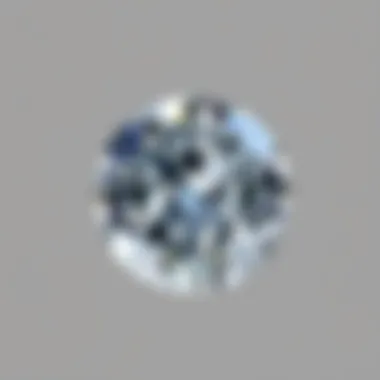
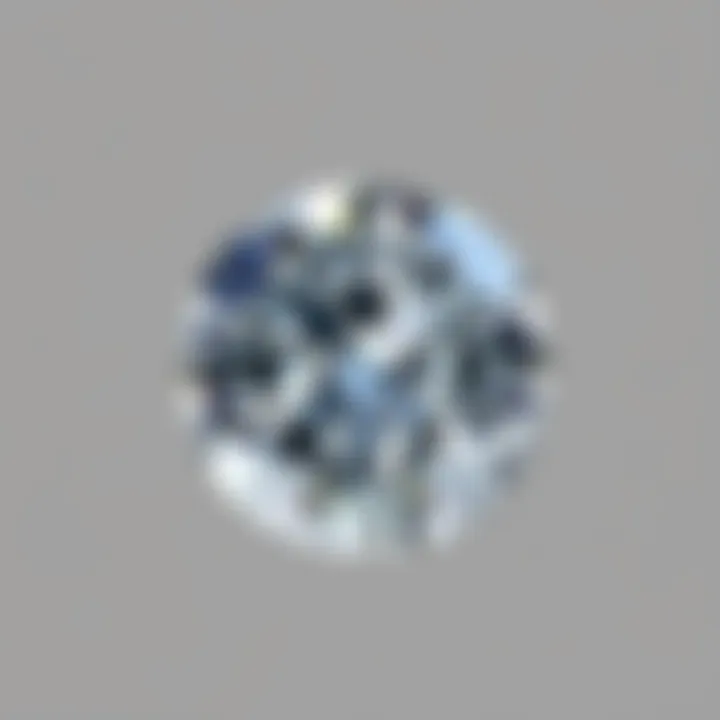
Preservation Tips for Specific Gem Types
Different gemstones require specific care methods. For example, opals are softer and need more gentle handling compared to diamonds. Recognizing these differences is key for collectors aiming to maintain their collection.
"A well cared for diamond tells a story over generations, capturing moments far beyond its initial sparkle."
Understanding Carats
When discussing diamonds, an essential concept that cannot be overlooked is the carat. This measurement acts as a cornerstone in the world of gemstones, providing a standard unit for assessing their weight. Understanding carats is pivotal because it helps enthusiasts, collectors, and jewelry designers navigate the complex landscape of diamond selection and valuation. From the novice searching for the perfect engagement ring to the seasoned collector hunting for rare stones, grasping the nuances of carats can significantly enhance the purchasing experience.
Definition of Carat
A carat is defined as a unit of weight equivalent to 200 milligrams. This standardization allows for an objective measure when it comes to diamonds and other gemstones. However, the term has evolved beyond just a numerical representation; it often influences perceptions of value and desirability. In the jewelry market, larger stones are usually more sought after, with a common belief that a higher carat weight garners more attention and prestige.
It's also worth noting that the term ‘carat’ is derived from the carob seeds historically used by jewelers to balance scales. Each seed weighed about 200 milligrams, leading to the widespread adoption of the term. This historical context provides a fascinating insight into how our understanding of weight measurement has roots in practical and tangible practices.
History of the Carat System
The carat system has a rich history that dates back to ancient times. Initially, it was not standardized, with varying definitions depending on the region and culture. As the trade of gemstones evolved, the need for a uniform measuring system became apparent. By the 19th century, gem traders and jewelers in regions such as Europe and the Middle East established the carat system we know today.
In 1907, the weight of a carat was officially defined in the metric system, solidifying its place as a benchmark in the diamond industry. The establishment of organizations like the International Gemological Institute further refined this system, ensuring consistency across borders.
Calculating Carat Weight
Calculating the weight of a diamond involves not just a simple measure but a combination of precision and understanding of how diamonds are cut. While the weight is straightforward for a one carat diamond—by definition, it weighs 200 milligrams—this does not account for how different cuts can alter the appearance and perception of size.
When examining a diamond’s carat weight, it's also important to consider the concept of millimeter size. This refers to the actual dimensions of the diamond, which can differ widely even when two stones share the same carat weight. A well-cut diamond may appear larger due to its proportions and symmetry. Factors such as the depth and width ratio significantly influence this visual aspect.
The Physical Properties of Diamonds
Understanding the physical properties of diamonds is crucial in grasping why these gemstones are so cherished and revered. It goes beyond mere aesthetics; it touches upon the very essence of their structure and formation. When talking about one carat diamonds, these physical characteristics inform everything from their beauty to their market value. Thus, a well-informed enthusiast can truly appreciate the depth behind their choice.
Chemical Composition
Diamonds are made primarily of carbon, but the story doesn’t end there. At the atomic level, each carbon atom is bonded to four other carbon atoms in a tetrahedral lattice. This arrangement gives diamonds their characteristic hardness. However, they can also incorporate trace elements during their formation, impacting their color and clarity. For example, the presence of boron can yield a blue hue, while nitrogen can result in yellow tinges.
It’s fascinating to note that lab-grown diamonds share this same chemical make-up. They are essentially identical to natural diamonds, prompting some debate in the industry as to their value. By grasping the chemical composition, collectors can better understand the unique qualities of different diamonds.
Formation Process
The formation of diamonds is a tale of immense heat and pressure. Usually, they develop about 100 miles underground, where intense conditions transform carbon into a crystalline structure over billions of years. There are two primary processes for their creation:
- Natural Formation through geological activity.
- Synthetic Production, where scientists replicate these extreme conditions in controlled environments.
Each process yields gems with intricate histories. Natural diamonds become vessels of time, while lab-grown diamonds offer an ethical and often more affordable alternative for enthusiasts. Understanding this formation process helps collectors form a connection to their diamond, recognizing it not merely as a jewelry piece but as a testament to natural history and scientific progress.
Optical Characteristics
The mesmerizing optical properties of diamonds—often referred to as the “fire,” “brilliance,” and “scintillation”—are the result of their unique internal structure and high refractive index. These properties play a major role in how light interacts with the stone, creating that iconic sparkle we all admire.
To better appreciate these optical characteristics:
- Fire: This refers to the rainbow of colors seen when light passes through the diamond.
- Brilliance: This is the white light reflected back to the eye.
- Scintillation: The sparkles that appear when the diamond is moved.
Every cut enhances these characteristics differently. A well-cut stone will maximize brilliance and fire, making it appear more vibrant. Understanding these traits not only elevates one’s appreciation for diamonds but also equips collectors with knowledge that aids in making educated purchases.
“A diamond’s beauty is not just in its size but in the way it plays with light.”
Cut, Clarity, and Color
When it comes to diamonds, three elements reign supreme in determining their beauty and value: cut, clarity, and color. Each of these factors contributes to the overall allure of a diamond, particularly a one carat gem. Understanding their intricacies can provide jewelry enthusiasts and collectors with an informed perspective while selecting that perfect piece. Let's dissect each factor.
Importance of the Cut
The cut of a diamond plays a pivotal role, akin to a chef choosing the right knife for a delicate dish. It's not merely about shape; it's about how well the diamond interacts with light. A well-cut diamond reflects light beautifully, showcasing its fire and brilliance.
Types of Cuts
Diamonds come in various cuts—round, princess, oval, emerald, and more. Each type contributes its own unique charm. For instance, the round cut is renowned for its classic elegance and exceptional light performance.
- Key Characteristics of Cuts:
- Round Cut: It’s the most sought after, known for its symmetry and ability to reflect light.
- Princess Cut: A favorite among modern tastes, it offers a square shape with stunning sharp lines.
- Emerald Cut: Its unique step-cut design gives off a vintage allure, often showcasing clarity more than sparkle.
The benefit of understanding these types lies in knowing how each cut manipulates light, which affects the diamond’s overall appearance and appeal. Not all cuts exhibit brilliance the same way, so this choice can make or break the appearance of a diamond.
Impact on Brilliance
The cut also directly impacts a diamond's brilliance, which refers to the amount of white light that reflects from its surface. Think of it as the difference between a dull light bulb and a vibrant one. A masterfully cut diamond can magnify the light, creating a dazzling effect that captures attention.
- Key Characteristic of Brilliance:
- Light Performance: This is where a well-executed cut maximizes the diamond's ability to refract light, showing off its true colors against a backdrop that captures every sparkle.
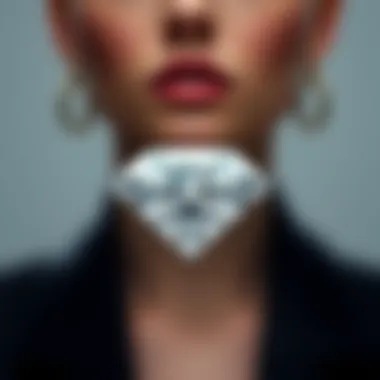

Think of the diamond as a small spinning star; the cut dictates how brightly that star will twinkle in the night. If the cut is poor, that twinkle dims, leaving behind a lackluster gem that fails to inspire.
Clarity Grading
Clarity grading assesses the presence, size, and type of inclusions or blemishes within a diamond. These tiny imperfections can hinder light's path through the gem and can affect its brilliance. A diamond's clarity grading, ranging from Flawless (no inclusions visible under 10x magnification) to Included (inclusions visible to the naked eye), plays a significant role in its valuation.
A higher clarity rating means the diamond is rarer and often is deemed more desirable. For those who appreciate the art of gemstones, learning to read clarity grades can enhance one’s ability to appreciate the intricate beauty of their diamonds—just as an art critic might analyze brush strokes in a painting.
Color Grading
Color grading is an essential factor in determining the quality of a diamond. Graded on a scale from D (colorless) to Z (light yellow or brown), the subtle differences in hue play a crucial role in the diamond's overall appearance. A colorless diamond not only appears brighter but also allows more light to pass through, enhancing its brilliance and fire.
Understanding these nuances adds depth to an appreciation of one carat diamonds. For jewelry designers and enthusiasts alike, a diamond above the G grade usually presents a "white" appearance, attractive enough to satisfy most trained eyes.
The Market Value of One Carat Diamonds
Understanding the market value of one carat diamonds is essential for both buyers and sellers. This segment reveals the multifaceted layers involved in assessing worth and purchase decisions. The diamond market is not just about the stone itself but also the larger economic principles at play which significantly influence pricing. Through this discussion, readers can gain a fuller appreciation of what a one carat diamond represents in terms of investment, craftsmanship, and emotional significance.
Factors Influencing Price
Supply and Demand
In any market, the principles of supply and demand reign supreme, and the diamond industry is no exception. When the demand for diamonds surges and the supply remains stagnant, prices inevitably rise. This phenomenon is particularly pronounced in one carat diamonds, which are often desired for engagement rings and significant life events.
The allure of a single carat stems from its balance between affordability and visual impact. Too many diamonds flooding the market can dilute their appeal, creating a scenario where values drop. Factors such as limited mining locations and the long processes of getting a diamond from the ground to a store shelf keep supply streamlined, effectively bolstering prices.
A key characteristic of this supply-demand dynamic is its volatility. Economic downturns, changes in consumer preferences, or enhanced transparency in sourcing can drastically alter the landscape, making it vital for potential buyers to stay informed.
Brand Influence
Brand influence plays a monumental role in the diamond marketplace. Certain established names, like De Beers or Tiffany & Co., carry significant weight. Their reputation, marketing strategies, and exclusive offerings can raise the perceived value of their diamonds, potentially placing them at a higher price point than lesser-known vendors.
The unique feature of brand influence lies in its power to shape consumer perception. Buyers often believe that diamonds associated with a reputable brand are of superior quality or craftsmanship, even if the raw material appears similar. This perception can create an advantage for branded diamonds, but also brings with it the disadvantage of inflated prices.
Investment Potential
One carat diamonds can be considered a dual-purpose purchase—enjoyment as a beautiful piece of jewelry coupled with long-term investment potential. Historically, diamonds have appreciated in value, reflecting their rarity and desirability over time. With proper research and choice, buyers can see diamonds as not just accessories but valuable assets. Investors are increasingly drawn to diamonds, particularly when considering portfolio diversification.
While the market can fluctuate, savvy shoppers are starting to view one carat diamonds as a hedge against inflation or currency instability. Knowledge of the market dynamics, combined with an eye for quality, can provide substantial returns.
Comparative Analysis with Other Gemstones
When pitting one carat diamonds against other gemstones like sapphires, emeralds, or rubies, the distinctions become vivid. Each stone holds unique qualities, both materially and culturally. For instance, a one carat ruby might be valued less than a diamond but can also offer stunning beauty and investment appeal.
In terms of price, diamonds tend to command a premium due to their widespread recognition, durability, and emotional significance (think love, commitment). However, colored gemstones have their enthusiasts, who appreciate rarity and aesthetic value over conventional pricing.
Purchasing a One Carat Diamond
When it comes to diamonds, the purchase of a one carat stone is an important milestone for many. Not just a financial investment, it also holds emotional value for people from various walks of life, be it for engagements, anniversaries, or just personal treats. Understanding how to navigate this process is paramount, as it ensures the buyer makes informed and sensible choices.
Where to Buy
Online vs. In-Store
Buying a diamond can feel like navigating through a maze. With the rise of the digital age, there’s a bustling marketplace online, yet traditional shops still hold their ground. Online purchases allow prospective owners to browse a plethora of options without leaving the comfort of their home. This access can provide competitive pricing and even time-saving advantages. Shoppers can compare prices with just a few clicks, and many reputable sites offer reasonable return policies.
Conversely, brick-and-mortar stores offer an experience that online platforms cannot replicate. The tactile pleasure of holding a diamond, seeing its sparkle in person, and getting direct feedback from a knowledgeable staff member is invaluable. However, this course often comes with a higher price tag due to overhead costs associated with operating a physical store. Each option harbors its own benefits. Online shopping is sleek and quick, while in-person visits allow you to gauge stones up close.
Reputable Dealers
When thinking about purchasing a one carat diamond, the choice of dealer plays a critical role. Reputable dealers have built their brand on trust and transparency. These individuals or establishments often offer certified diamonds, which lets buyers rest easy knowing they are acquiring a genuine product. In many cases, they possess extensive knowledge in the field, guiding customers through the myriad of choices available.
Buying from a recognized source can sometimes cost more than lesser-known vendors, but the trade-off is peace of mind. You know you are not dealing with a fly-by-night operation. Places like James Allen, Blue Nile, or even local independent jewelers with strong reputations provide a spectrum of options while ensuring the integrity of the purchase.
What to Look For
The checklist for selecting a one carat diamond can feel overwhelming. The following attributes are key:
- Cut: The most important determinant of a diamond's brilliance and overall appeal.
- Clarity: Assess how many imperfections can be spotted. A higher clarity grade means your diamond is likely to look more perfect.
- Color: Ranging from colorless to slightly yellowish, a more color neutral diamond is usually considered more desirable.
Focusing on these factors can make or break your purchase.
Insurance and Appraisal
Following the purchase, safeguarding your investment is vital. Insuring your diamond ensures that you will be compensated in the event of theft, loss, or damage. Many jewelers offer appraisal services as part of the purchase. However, seeking independent valuations ensures impartiality. The appraisal document should detail the carat weight, cut, clarity, and any unique features of the diamond.
In summary, navigating the diamond market requires careful thought and scrutiny. Choosing where to buy, the dealer’s reputation, what to look for, and ensuring adequate insurance are all essential parts of the puzzle that further enrich the experience of owning a one carat diamond.
Care and Maintenance
Taking care of a one carat diamond is almost like nurturing a delicate relationship; the more effort you put in, the more it shines. Proper care and maintenance play a vital role in ensuring that a diamond retains its brilliance and beauty over the years. Many forget that a diamond, while one of nature's hardest substances, is not impervious to damage or dullness.
Keeping a diamond pristine involves regular cleaning, proper storage, and dispelling some common myths surrounding its maintenance. This attention not only impacts the diamond’s aesthetic appeal but also its overall value. A well-maintained diamond can tell a rich story over generations; who wouldn’t want that?
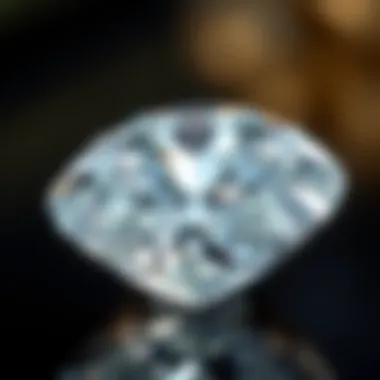
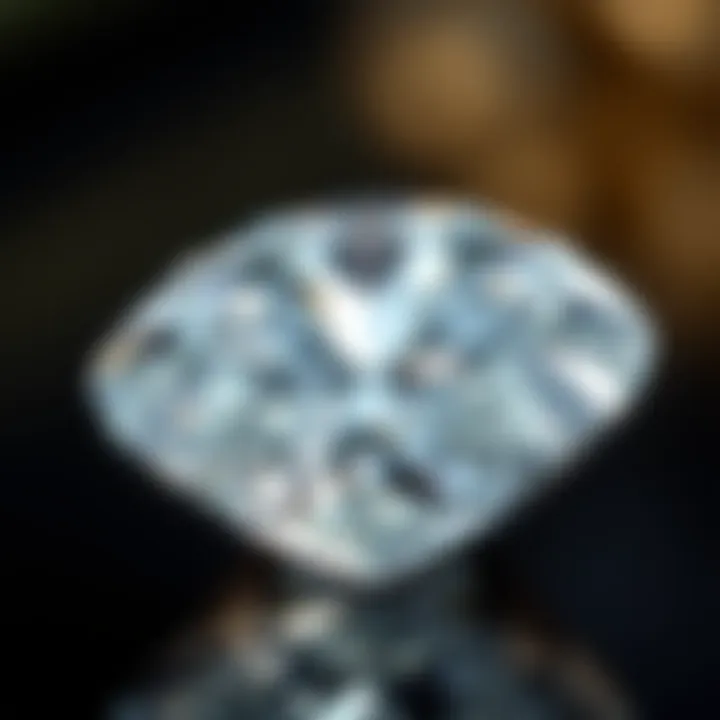
Cleaning Techniques
Cleaning a one carat diamond isn’t just about giving it a quick rinse under a faucet. Regular, gentle cleaning is the key to removing grime and oils that have built up over time. To keep your diamond sparkly and fresh, consider the following techniques:
- Soap and Water Solution: Mix a few drops of mild dish soap in warm water. Submerge the diamond for around 20 to 30 minutes. Afterward, use a soft toothbrush (mind the bristles!) to carefully scrub any crevices, finally rinsing under clean water.
- Ultrasonic Cleaners: These devices can be effective, but a word of caution is needed. While they do a great job in loosening dirt, you must ensure that your diamond's setting can withstand such vibrations. If unsure, stick to the homemade methods.
- Professional Cleaning: Visiting a jeweler once every couple of years for a thorough cleaning is a good practice. Not only do they clean the diamond effectively, but they also check for any damage or wear that might go unnoticed.
Storage Advice
Where you store your diamond can be just as important as how you clean it. Proper storage helps preserve its luster and protects it from scratches and other mischief. Here are some tips:
- Individual Wrapping: Store your diamond in a soft cloth pouch or wrap it in a soft material. Keeping it separated from other jewelry can help avoid scratches.
- Avoiding Humidity: Store your diamond in a cool, dry place, as excessive humidity can cause tarnishing in the metal settings.
- Safely Secured Spaces: Ideally, keep your diamond in a secure jewelry box with compartments. Many use boxes that come lined with fabric to safeguard gems against any accidental chipping.
Common Myths Debunked
When it comes to diamond care, misconceptions abound like weeds in a garden. Busting these myths can save you a headache and protect your beloved gem:
"Diamonds never require cleaning."
This is far from the truth. Diamonds attract oils and dirt, which can make them appear dull. Regular cleaning is essential to maintain their sparkle.
- Myth: "Soap will damage the diamond."
- Myth: "Storing your diamond with other jewelry is fine."
- Truth: Mild soap is safe and even helpful in keeping your diamond clean; it's harsh chemicals that pose a threat.
- Truth: Mixing them up can result in scratches and potential damage; keep them separated!
Being informed about proper care solidifies the notion that diamonds are not just beautiful pieces of jewelry, but cultural treasures that deserve attention and respect. Just as we value the stories behind them, let's take care of them, making sure they shine brightly for many generations to come.
For more on gemology and diamond care, you might check resources like GIA and American Gem Society.
Cultural Significance
The cultural significance of one carat diamonds extends far beyond their intrinsic value. These gemstones have been woven into the fabric of human history, symbolizing love, power, and status across various cultures. Understanding this significance can enhance a collector's appreciation of diamonds as more than mere commodities; they become significant artifacts of social and cultural identity.
Diamonds are often seen as the pinnacle of luxury and are associated with wealth. However, their meanings vary dramatically from one culture to another. This section will explore the historical contexts of diamonds, their symbolism across cultures, and their notable roles in traditions and celebrations.
Historical Context
Historically, diamonds have held significant value, tracing their roots back to ancient India, where the first diamond mines were discovered. For centuries, diamonds were believed to hold mystical powers, thought to protect their wearers in battle or bring good fortune. Greek philosopher Aristotle noted that diamonds were tears of the gods, adding a layer of mythological allure that continues to captivate.
During the Middle Ages and the Renaissance, diamonds became synonymous with royalty and aristocracy. Kings and queens adorned themselves with massive diamonds, not just for their beauty but symbolizing their divine right to rule. This association with power persists in modern times, where diamonds are often featured in royal crown jewels.
As diamonds were more widely marketed in the 20th century, they became symbols of love and commitment, largely thanks to advertising campaigns from brands like De Beers. Their iconic phrase, "A diamond is forever," has cemented their place as the go-to choice for engagement rings globally.
Symbolism in Various Cultures
The symbolism attached to diamonds can be both intricate and varied. In many cultures, diamonds symbolize eternity and longevity due to their remarkable hardness.
- In Hindu culture, diamonds are associated with the planet Venus and are thought to bring passion, prosperity, and harmony in relationships.
- For Christians, diamonds have represented the purity of Christ, capturing the divine light.
- In Chinese culture, the density of a diamond can signify strength and lasting bonds, making them popular gifts during significant life events.
Such varied symbolism gives a deeper meaning to the stone. Understanding these cultural associations can inform choices regarding designs and settings that resonate with the wearer's identity.
Role in Traditions and Celebrations
Diamonds frequently appear in various traditions and celebratory events. They take center stage during milestone moments—from engagements and weddings to anniversaries and commemorations.
In many weddings, for instance, a one carat diamond ring signifies commitment and the promise of an everlasting bond. This tradition has been bolstered by media portrayals, making it commonplace in many parts of the world.
In addition to personal celebrations, diamonds are also present in culture-wide festivities, whether it's part of cultural jewels in ceremonies or even in royal events. For instance, the annual King`s Birthday celebrations in Netherlands often reveal the use of diamond brooches as part of traditional state attire, depicting loyalty and historic ties.
"Diamonds are not just about the sparkle; they tell a story of culture, love, and human connection."
The intricate role of diamonds in personal and cultural traditions reflects their significance. They embody not just wealth, but also the emotions, memories, and milestones that people cherish throughout their lives.
Environmental and Ethical Considerations
As diamond enthusiasts and collectors delve deeper into the realm of one carat diamonds, understanding the environmental and ethical implications becomes increasingly vital. The conversation around the diamond industry has shifted in recent years, with a noticeable emphasis on sustainable practices and ethical sourcing. This isn't just a new trend; it's a significant shift toward accountability and conscientious consumerism.
Impact of Diamond Mining
Mining for diamonds has a massive impact on both the environment and local communities. The traditional method of extraction often involves open-pit or underground mining, which not only disturbs large areas of land but also causes significant ecological damage. Habitats are disrupted, and biodiversity is threatened. Moreover, many diamond mines are located in sensitive areas where wildlife flourishes, leading to potential extinction of vulnerable species.
From a human perspective, diamond mining can have dire consequences for local populations. In some regions, this practice has been linked to human rights abuses, including unfair labor conditions and exploitation of workers. There's a growing demand for transparency in how diamonds are sourced. Consumers increasingly want assurance that the diamonds they purchase are conflict-free, meaning they were not sourced from war-torn regions where sales fund violence.
"Diamonds can be a double-edged sword; they offer beauty and significance but also come with a dark shadow if not ethically sourced."
Lab-Grown Alternatives
In light of the negative impact of traditional mining, lab-grown diamonds have emerged as a compelling alternative. These diamonds are created in controlled environments, mimicking the natural processes that form diamonds under the earth’s surface. One of the most significant benefits of lab-grown diamonds is their environmental footprint, which is considerably lower than that of mined diamonds.
Lab-grown diamonds allow for a more ethical approach to sourcing. They bypass the moral dilemmas associated with conflict diamonds and offer consumers a clearer conscience. However, misconceptions linger. Some people still hold the view that lab-grown stones lack the allure of natural diamonds. In reality, they possess the same physical and chemical properties, making them indistinguishable from their mined counterparts.
Sustainable Practices
Sustainable practices are integral to reshaping the diamond industry for the better. Companies that prioritize sustainability are increasingly focusing on responsible mining operations and fair trade practices. This includes minimizing waste, rehabilitating mining sites, and ensuring fair wages for workers.
Efforts to incorporate sustainable practices go beyond the mining phase. Jewelers are also beginning to consider the entire lifecycle of a diamond, from extraction to consumption. For instance, better waste management and recycling practices help minimize environmental damage. Another promising step is the formulation of ethical certifications that assist shoppers in identifying responsibly sourced diamonds.
For more insights on environmentally friendly gemstones, visit Wikipedia and Britannica. Look for sustainable jewelers on platforms like Facebook or even threads on Reddit discussing the industry.







